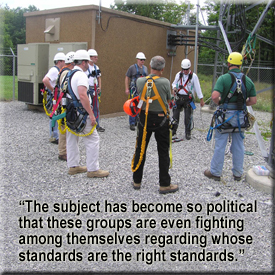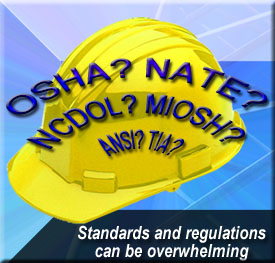|
Confused employers find little standardization in tower safety requirements tower safety requirements
By Winton W. Wilcox, Jr,
Employers of tower climbers trying to comply with regulations, standards and policies are doomed. First there is the legal need to comply with OSHA regulations. Second there is an increasing demand to meet the policies and standards as set by clients and property owners to avoid liability. Now NATE, NCDOL and ANSI as well as EIA/TIA have each published their own standards for employers to follow! All of these entities are self declared experts in tower safety. Each of these groups has produced "Tower Safety Standards," and by the way, MIOSH is reported to be progressing with their own version of these standards.
Each group was genuinely trying to provide clarification and guidance to employers who are charged with this responsibility; however, collectively they have successfully complicated the employer's task of complying. The subject has become so political that these groups are even fighting among themselves regarding whose standards are the right standards.
Employer's policy includes hanging by teeth warning
The employer is responsible to provide safety training or accept training specific to the potential hazards that his/her employees are exposed to in the course of their jobs. This is a nearly impossible task. I have a client in the Northeastern US who has a safety policy that states that "no employee may hang from a rope by his/her teeth". While this may sound preposterous it derived from a case where a climber, who was working on a descent line, decided to provide safety by holding the rope above the descent control tool with his teeth while unlocking the descent tool. The result was damage to his teeth which was charged against my client because "the employee was never told that holding the rope in his teeth was dangerous".
As a guide to providing training and safety equipment the Federal Government, through OSHA, provides standards which are the minimum guidelines for the employer to meet in his safety training program. Unfortunately these minimum guidelines are not collected in a single source labeled "Minimum Safety Guidelines for Tower Climbing Safety and Rescue Training and Equipment". In all fairness, North Carolina's Department of Labor in an effort to clarify this matter has worked diligently to provide just such a guide.
 It is not unusual for employers to seek expert advice and guidance. Most employers are pretty fair accountants and can analyze basic financial statements but still rely on professional accounts (tax accountants, management accounts and financial accounts) for help. Most employers of tower workers are pretty good riggers, construction managers and skilled technicians but still rely on machinists and even engineers for help. The need for, cost justification of and dependence on outside advice is determined by the employer's objective. If the objective is to comply with legal and/or governing bodies then the value of the expertise is that it provides understanding of the law or regulations and the employer's relationship to the law or regulation. If the objective is to collect certification or license to provide opportunities then the value of the expertise is to gain awareness of and understanding of the required credentials and guidance in obtaining those recognitions. Good advisors are those who clearly understand the objective and can communicate pragmatically to the employer the actions required to meet the objective. It is not unusual for employers to seek expert advice and guidance. Most employers are pretty fair accountants and can analyze basic financial statements but still rely on professional accounts (tax accountants, management accounts and financial accounts) for help. Most employers of tower workers are pretty good riggers, construction managers and skilled technicians but still rely on machinists and even engineers for help. The need for, cost justification of and dependence on outside advice is determined by the employer's objective. If the objective is to comply with legal and/or governing bodies then the value of the expertise is that it provides understanding of the law or regulations and the employer's relationship to the law or regulation. If the objective is to collect certification or license to provide opportunities then the value of the expertise is to gain awareness of and understanding of the required credentials and guidance in obtaining those recognitions. Good advisors are those who clearly understand the objective and can communicate pragmatically to the employer the actions required to meet the objective.
Laws and standards by definition set many employer objectives. A law is a "rule of action established by authority or enactment of a legislative body". A standard is "that which is established by authority as a fixed rule or measure". In the tower industry if the employer is looking for clarification of his objective he normally consults the "law" or the "standard". Consulting the law in terms of safety training is to consult OSHA or in the state of North Carolina, NCDOL. These agencies carry the weight of "authority" through legislative enactment. What provides NATE or ANSI or EIA/TIA with the weight of "authority"?
In a search for guidance, the property of a standard is to provide measurement. A cursory reading of the standards being offered to the industry includes such statements as:
Students must:
Be present for the training
Make efforts to understand material
Listen to company policy and regulations
Ask regulatory questions if they are unsure
Students are provided:
An introduction to the instructor
Lecture/Demonstration
Instructors must be:
Competent
Some of the standards are more measurable and refer to specific statements made in the law (OSHA CFR's) but most are vague subjective statements.
Consider these new standards in another light; are the publishers of these standards actually training? OSHA has made measurable gains in the last couple of years with the development and delivery of the OSHA 10-hour Tower Safety Course and the provision for OSHA provided training for instructors of this course. The OSHA 10-hour Tower Safety Course is an adaptation of the traditional OSHA 10 Hour Safety Course. This adaptation has been made more effective through the subject matter expertise provided by such organizations as NATE and by experienced tower workers. Has ANSI ever conducted, measured or beta tested any safety training; has NATE or EIA/TIA? What are the academic standards or quantifiable elements of the training? Can an employer follow these standards and meet his objectives of complying with either the law or the recognition by clients and owners of effective training? These new standards appear to be more an exercise in social science than an attempt to provide employers and clients with constructive assistance. Incidentally, most of these new standards contain more disclaimers than an insurance policy.
Standards in safety training have been set and tested for many years. Rose Manufacturing (now owned by MSA) developed and delivered fall protection training years ago and the training was supported by testing and by developing solutions to hazards. Miller (now Christian Deloz) developed fall protection training and many other manufacturers also set standards in fall protection. Experts do exist in fall protection such as Dr. Nigel Ellis and Andrew C. Sulowski. P.Eng., of which all have tested, delivered and developed effective training in their fields.
The real issues and needs for standards is to collect the standards developed relative to specific hazards such as fall protection and appropriately adapt them to the situations encountered in working on towers. From these adaptations there is a need to establish feasible implementation standards. Such issues as when training is required, when practice is required, how to update training and support to worker safety. Many of the current publishers are resistant to requiring training for new employees. Why? The only apparent answer is cost.
"If I have to train and provide safety equipment for a new employee it will cost a lot of time and money and he/she might be gone in a short time". Most of the new standards suggest a staged level of training such as "Tower Safety Awareness" being the basic safety training before letting a worker climb a tower. If the employee makes it through a few months then have "Advanced Tower Climbing Safety Training" then after an additional period of time we could teach "Tower Rescue Techniques" and for good long term employees we might have "Advanced Tower Rescue Techniques". This makes even less sense. If you are climbing and working on towers you are exposed to the dangers and need to understand those dangers and how to avoid them. Imagine learning to drive in this staggered, cost effective approach. "How to Drive - a 4 Hour Lecture" required before driving a car, then after driving for a few hundred miles you must take "Practical Driving - a Hands on Approach to Driving", after driving a few hundred more miles you could take "Defensive Driving - How to Effectively use Rear View Mirrors, Turn Signals and Brakes".
Which standard do you follow? You can spend hundreds of dollars buying a copy of the latest standards. Yes we need standards; but are these new self proclaimed documents a solution?
It appears that as usual the employer is left up to his/her own devices. To be effective the employer needs to clearly define the objective then consider the alternatives to meeting the objective(s) and select the best options. Read, study and solicit advice on the regulations, review and consider the requirements of owners, clients and business associates, review existing programs and materials for pertinence to your objectives and make providing your employees with the best training and equipment available for their safety your first priority. There is a long recognized formula to business success that lists priorities as being "People, Product, and Price," and in that order. Make your people first, protect them and you will be effective.
 Winton W. Wilcox Jr. is Founder and President of ComTrain LLC, Monroe, WI. Winton is an accredited Jr. College instructor in both California and Wisconsin and has authored a publication on tower climbing safety and rescue. He is also a frequent contributor to national media. Winton W. Wilcox Jr. is Founder and President of ComTrain LLC, Monroe, WI. Winton is an accredited Jr. College instructor in both California and Wisconsin and has authored a publication on tower climbing safety and rescue. He is also a frequent contributor to national media.
raduate of “The Carolina School of Broadcasting” 1965, “University of Nevada/Reno” 19Scien
|